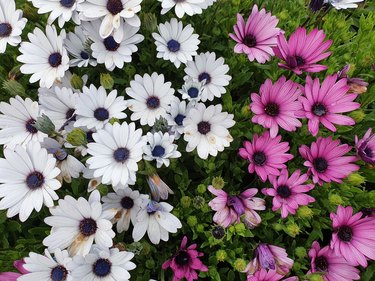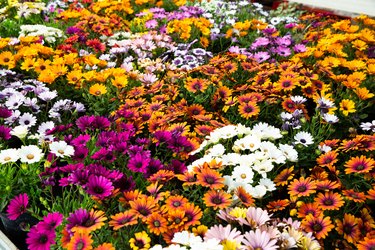
The bright colors of African daisies (Osteospermum spp.) have endeared them to gardeners in the warm climates of U.S. Department of Agriculture plant hardiness zones 9 through 11. These perennial South African flowers require regular watering to thrive and produce their colorful blossoms in early summer and again in fall. Members of the daisy family, they share their common name with other daisy-like annual and perennial species.
Tip
Keep the soil evenly moist and fertilize regularly to keep your African daisies blooming. In general, apply water when the soil or potting mix is dry to a depth of 1 to 2 inches.
Video of the Day
About African Daisies
African daisies, also known as South African daisy, blue-eyed daisy, Cape daisy and daisybush, are native to South Africa. The Osteospermum species were once classified in the Dimorphotheca genus, but were moved to their own genus, leaving only the annual species – also known as African daisies – in the original group.
Video of the Day
With more than 70 African daisy species, you can choose flowers with blue or yellow centers and a variety of petal colors, ranging from solid to multicolored in white, pink, red, yellow, blue and purple. Many of the cultivars are hybrids and won't produce viable seeds. Instead, transplant in spring and divide as the plants outgrow their containers or space in the garden.
African Daisies in the Garden
Prepare a sunny, well-drained garden bed by digging in 2 to 4 inches of compost. Transplant into the garden in early spring, after the last frost date has passed. African daisies prefer milder days and nights, and can tolerate night temperatures down to 40 degrees Fahrenheit, but protect with frost blankets, old sheets or plastic sheeting suspended on stakes if a late frost threatens.
Dig planting holes 12 to 24 inches apart, depending on the mature size of the cultivar, and fill with water. Allow the water to soak into the soil, then plant your African daisies at the same depth as they were in the growers pots.

If planting in containers, use a well-drained, organically rich mix or make your own by combining equal parts peat moss, compost and perlite or coarse sand. African daisies prefer slightly acidic soils, approximately 5.5 to 6.0 pH level.
African Daisy Watering and Care
Keep the soil moist, but not waterlogged, after transplanting. Water when the soil is dry to a depth of 1 to 2 inches, generally at least 1 inch of water weekly. Container plants may need daily watering in hot weather. Use soaker hoses, hose end bubblers or drip systems for African daisy watering to avoid wetting the foliage.
Add a 3-to-4-inch layer of mulch around the plants, pulling it back 4 inches from the stems. Fertilize with a water-soluble fertilizer weekly or use a slow-release fertilizer formulated for flowers. Deadhead the flowers as they fade. When hot weather arrives, shear the plants by one-third and continue to fertilize; when cooler temperatures return, you'll have a flush of flowers for the fall garden.
Take cuttings to produce new plants. Remove the lower leaves and swirl the cut end in rooting compound. Place in moist potting mix and place in a brightly lit, warm location. After new growth appears, transplant into flowerpots or a sunny garden.
Annual and Perennial Daisy Types
Another of the many members of the Asteraceae family, the Cape marigolds (Dimorphotheca sinuate) are also known as African daisies. Cape marigolds are annuals, while the Osteospermum African daisies are mostly perennials. These annuals freely reseed in the garden; use caution when planting in the warmer zones where they may become invasive.
In addition, the Arctotis species are among the perennial daisy types and, to further confuse the issue, are called African daisies, too. Hardy in USDA zones 9 through 11, there are numerous Arctotis cultivars and hybrids that also sport cheerful, bright colors.

The annual African daisies and some of the perennials can be grown from seed. Plant seeds in a sunny garden bed or indoors in biodegradable pots. Barely cover with moist mix or damp sand and keep at 60 to 65 degrees Fahrenheit. The seeds will germinate in seven to 21 days, depending on the species and cultivar.